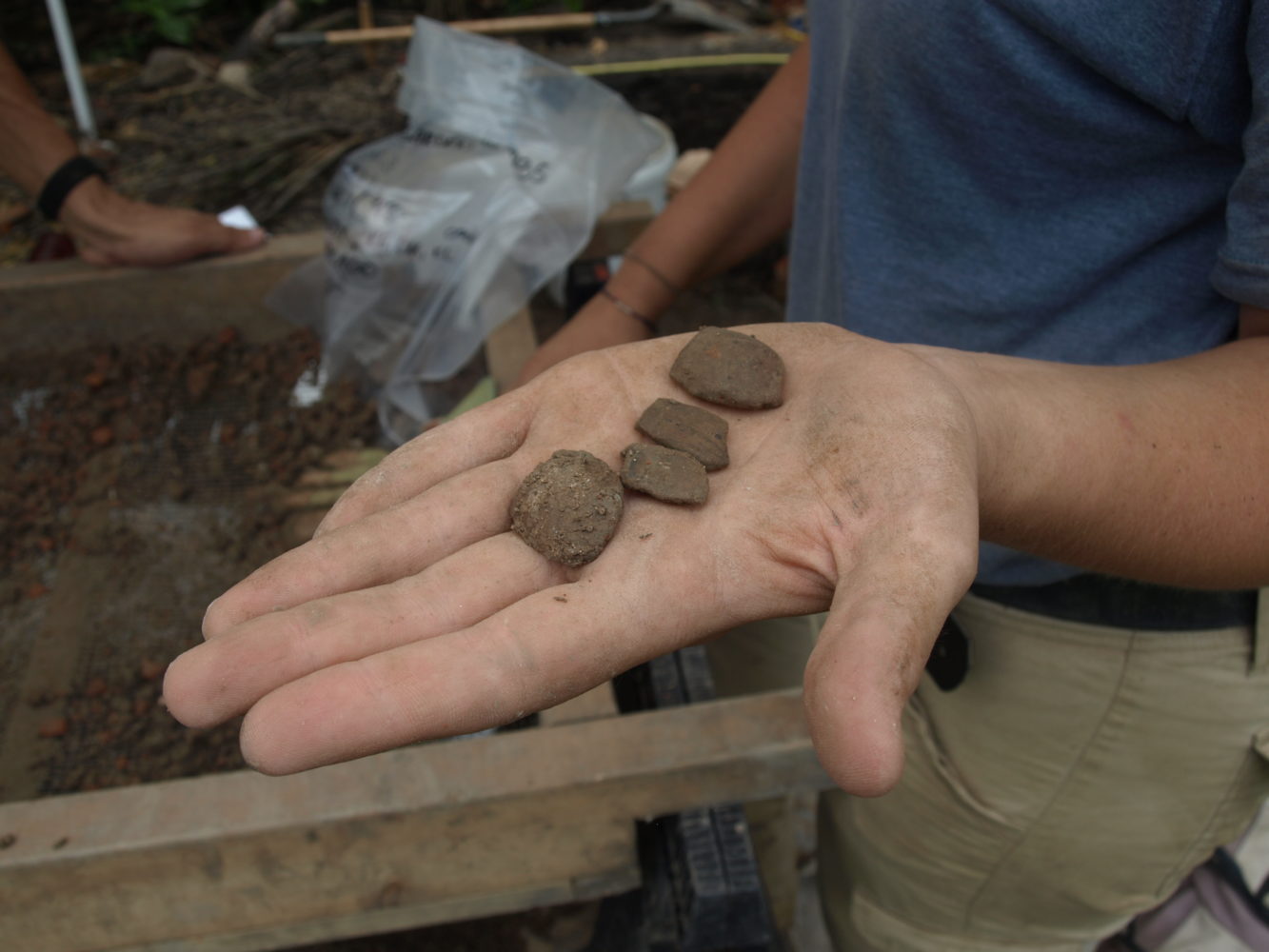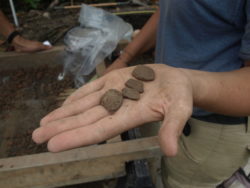Archaeology of the New Orleans Area
In New Orleans archaeological explorations span 2,500 years of history

Photo by Adela Amaral
Fragments of a handmade smoking pipe from St. Anthony's Garden.
The New Orleans area contains hundreds of archaeological deposits, which hold the hidden story of the city’s Native American, colonial, antebellum, and more recent past. These fragile remains provide direct, tangible connections to Louisiana’s history. Archaeologists have identified more than seven hundred archaeological sites in metro New Orleans, but only a few have been subject to intensive scientific examination. Those that have been studied include domestic residences from various socio-economic and ethnic groups, government and institutional buildings, businesses and industries, cemeteries, fortifications, plantations, and prehistoric and early historic Native American settlements spanning 2,500 years. Evidence gathered from the excavation of these sites provides information about people’s diets, social interactions, technology, physical conditions, traditions, cultural change, and cultural continuity. Furthermore, the results of previous archaeological investigations suggest that many more archaeological sites lay intact underneath buildings, courtyards, and green spaces of the modern city, awaiting future discovery.
Native American Settlement in the New Orleans Area
Before the establishment of New Orleans, the area was home to various Native American groups for at least 2,500 years. In the Bayou Sauvage marshland just east of the city, archaeologists have uncovered evidence of the earliest settlers in the region near the Little Woods community. The people of the Tchefuncte Culture (800 BCE–1 CE) exploited the brackish-water clam (Rangia cuneata), along with other animals drawn to the beds to eat the clams. Tchefuncte people created large middens (trash heaps) of discarded shell left over from this shellfish consumption. Animal bone; pottery; tools made from stone, bone, and shell; and other artifacts discarded into the middens provide archaeologists with insight into prehistoric lifeways. Two of these sites, Big Oak Island and Little Oak Island, were listed together in the National Register of Historic Places in 1971. The Oak Island sites represent some of the last vestiges of a once widespread Native American population living in the coastal area surrounding New Orleans.
During later prehistoric times, settlement occupation shifted toward the Barataria Basin south of the city. Archaeologists are still learning how the native societies of the Mississippi period (1200–1700 CE) and their descendants utilized the landscape surrounding New Orleans. Researchers once thought modern development had destroyed most Native American sites. However, investigations at the Rising Sun Hotel (now part of The Historic New Orleans Collection’s complex) in the French Quarter, Spanish Fort along Bayou St. John, and Kingsley House in the Lower Garden District have unearthed sites that might predate the French settlement of New Orleans.
In the eighteenth century, Native American tribes played an active role in colonial society. In New Orleans, archaeologists have recovered native, shell-tempered ceramics found together with European-manufactured artifacts at several colonial-period sites. Finding aboriginal ceramics at colonial households suggests there were important social interactions and trade relations between native societies and colonial settlers.
Daily Life in New Orleans
The most common type of archaeological site in New Orleans is associated with a household residence; many of these doubled as businesses. Archaeological investigations at house lots provide a glimpse into the private lives of city residents. Lot features such as trash pits, privies, and wells usually contain abundant artifacts which are used by archaeologists to interpret the lifeways of those who lived and worked at the site.
The Gallier House complex was the first historical archaeology project conducted in New Orleans. Excavations in 1970 provided important information about building techniques and commercial life between the 1830s and 1850s. Subsequently, investigations conducted at the Hermann-Grima House by archaeologists from Tulane University and the University of New Orleans revealed that residents were elevating their living surfaces in the flood-prone city whenever possible. Excavations elsewhere in the city indicate that this practice was common.
Carefully excavated sites provide a wealth of information about past diet and food consumption patterns through the recovery of animal bones, seeds, and food preparation and storage artifacts. Archaeologists compare household assemblages of these items both over time and across the city during a single time period to address questions concerning consumer choices, availability of resources, and cultural preferences. Research conducted by Shannon Lee Dawdy and Elizabeth Scott indicates that during the colonial period, first-generation New Orleanians tried to recreate their familiar European diet. In contrast, the native-born second generation incorporated more wild game and native resources into their cuisine, likely forming the beginning of the city’s unique culinary traditions.
Archaeology of Disaster
Disastrous events, such as fires and floods, leave a recognizable imprint in the archaeological record. Among the most identifiable disasters in New Orleans’s archaeological record are two large fires that swept through the French Quarter in 1788 and 1794. Researchers have documented the city-wide fires from at least six different sites. Recognized by the remains of charred timbers and artifacts burned at high temperatures, the burn layers provide a rare snapshot of life during the Spanish colonial period, as well as a handy dating tool for deposits above and below the burn level.
Archaeology reveals that colonial residents took different approaches to rebuilding after the two fires. At Madame John’s Legacy, archaeological research suggests the bottom portions of the structure survived the 1788 fire. Builders used the surviving portions of foundations to reconstruct the original French-colonial style. Other residents chose to construct new architectural styles and take steps to mitigate against possible impacts of future fires. At 400 Chartres Street, archaeologists from Earth Search, Inc., and the University of New Orleans uncovered the remains of a two-story townhouse built just after the 1794 fire. Based on the archaeology, the builder used heavy brick foundations to support brick walls, plastered the walls with thick stucco, and covered the roof with clay tiles to make the townhouse less flammable. These preventative measures proved successful. When the building next door caught fire, the fire did not spread to the townhouse. This, along with other archaeological information gleaned from these sites, provides an important understanding of how former residents of the city coped with and recovered from disaster.
Government Buildings, Institutional Spaces, and Military Fortifications
Unfortunately, archaeologists have only excavated a handful of sites dating to the French colonial period (1718–1769). However, in 1991, archaeologist Jill-Karen Yakubik uncovered the foundations of the Royal Military Barracks (built circa 1731) below modern buildings in the 700 block of Toulouse Street. The site provides some of the first significant archaeological contributions to understanding the French colonial period. In 2008, University of Chicago archaeologists uncovered the remains of the earliest colonial structure to date associated with the colony’s land-clearing days. Located behind St. Louis Cathedral in St. Anthony’s Garden, the orientation of this simple hut (circa 1717–1726) suggests that it predates the colonial street grid (established circa 1722). Excavations at the Cabildo, conducted by Earth Search, Inc., uncovered the foundations of the earliest prison in New Orleans, built in the 1730s. The Cabildo served as a municipal center and was used as a jail for around one hundred years. Following the Louisiana Purchase, the site was still functioning as a civil prison. The collection of animal bones found at the site and dating to between 1800 and 1840 indicate a meager diet; and a large number of rat bones suggests filthy living conditions for prisoners. Bone button blanks show that prisoners were engaged in button manufacturing.
During the 1790s, Spanish officials improved the city’s defenses by constructing five defensive structures, linked by ramparts and a moat, encircling New Orleans. As the city expanded beyond the French Quarter, development erased the city’s military features from the landscape. However, University of New Orleans archaeologists have uncovered evidence of two of these early forts. Located beneath the Old US Mint, Andrea White excavated portions of the moat and picket posts that formed the rampart wall of Fort St. Charles (Fort San Carlos), the largest of the forts. In the 1970s, construction associated with Louis Armstrong Park led Richard Shenkel and Edward Chatelain to unearth timbers thought to be the remnants of Fort St. Ferdinand (Fort San Fernando).
Death and the Archaeology of New Orleans Cemeteries
Cemeteries are another type of archaeological site. Their examination can provide insight to the cultural practices of the living, as well as tell the story of the deceased. As New Orleans expanded, some cemeteries were forgotten because they contained burials interred below ground and were no longer visible on the landscape. Archaeological investigations of two such cemeteries have contributed to the understanding of the physical demands of life in New Orleans. The St. Peter Street cemetery was the city’s first official burial ground. In use from circa the 1720s until 1789, when St. Louis Cemetery No. 1 was established, it served as the primary burial grounds in New Orleans during the French and Spanish colonial periods and was depicted on colonial maps. The cemetery was rediscovered during a construction project in 1984. Doug Owsley and Charles Orser recovered twenty-nine burials, which represent one of the earliest samples of a colonial population at that time. Research on the skeletal remains indicates that burials were unsegregated. Those of African, European, and American Indian heritage, including people with mixed ancestry, shared the same space after death. In 2011, construction activities prompted archaeologists to return to the site and exhume additional individuals. The human remains were reburied in a special ceremony in 2015.
Between the 1850s and the 1920s, the Charity Hospital Cemetery No. 2 served as the final resting place for thousands of indigent New Orleanians who died while receiving hospital care. In 1985, University of New Orleans and Louisiana State University archaeologists and physical anthropologists removed more than 150 burials prior to road improvements along Canal Boulevard. Bioarchaeology of this working-class population provides unique information on medical practices, health, and disease in the late nineteenth century. Examination of the skeletal remains revealed chronic conditions like arthritis, bone infections, inflammation, anemia, and bone fractures. Poor dental hygiene led to high frequencies of cavities, abscesses, and tooth loss. Due to the cemetery’s association with Charity Hospital, students and doctors often conducted post-mortem exams or used the recently deceased for surgical experimentation and practice. The remains examined from Charity Hospital Cemetery No. 2 are unique because the evidence of procedures associated with medical education are rarely observed in historical skeletal collections.
Plantations and Urbanization
While many of the historical archaeological investigations in New Orleans have focused on the earliest sites clustered around the French Quarter, archaeologists have documented several other important archaeological sites. Many of these sites are associated with the region’s growth during the nineteenth century; these include Orange Grove Plantation in Jefferson Parish and the Duplessis Plantation (discovered underneath the Maginnis Cotton Mill in the Central Business District). Numerous other plantations sites line the Mississippi River and have been archaeologically investigated to varying degrees.
Within the city limits, archaeologists have conducted several large-scale excavations such as those in the Tremé, Holy Cross, and Lower Garden District neighborhoods. These excavations uncovered evidence of business, domestic, and institutional sites associated with the urbanization of New Orleans, when many immigrants arrived in the city during the nineteenth century. Based on the excavations at twenty-four immigrant households, Coastal Environments, Inc., recognized socioeconomic differences between the household artifacts assemblages. However, there were notable similarities among households with different ethnic backgrounds, suggesting that as second- and third-generation immigrant groups adapted to their new home, they all were becoming New Orleanians.
In the twenty-first century, New Orleans continues to change. The rebuilding of the city following Hurricane Katrina has resulted in numerous new archaeological investigations. This post-Katrina work includes projects at Jackson Barracks, the sites of the new Veteran’s Affairs and state hospitals, and several locations associated with the redevelopment of the city’s public housing. Archaeological interpretation of these sites is underway and will provide more information to refine our understanding of New Orleans’s past.
